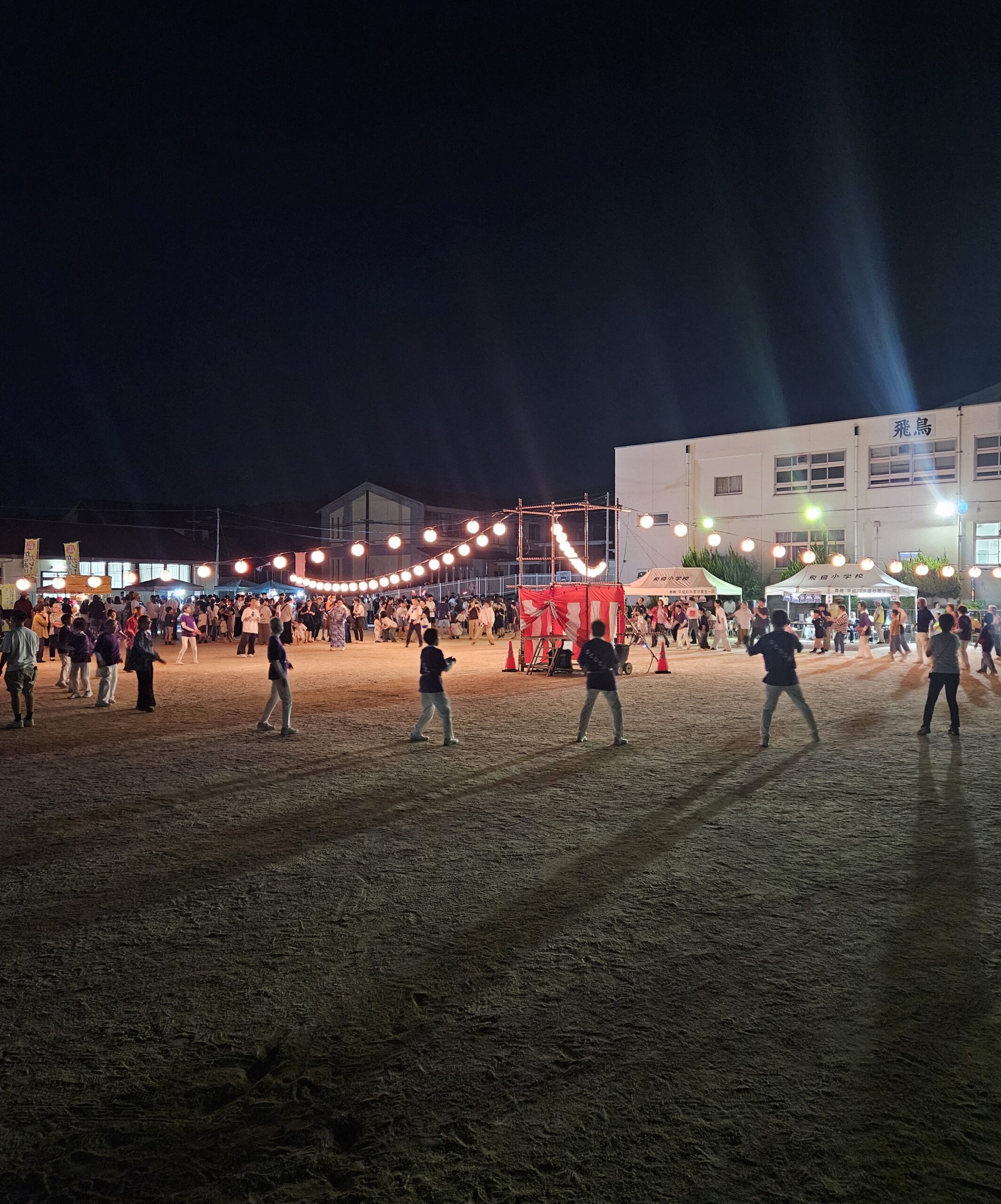🏮 Dancing with Ancestors: A Local Bon Odori at My School
A poetic journey into Japan’s summer traditions, community spirit, and ancestral connection.
- Introduction: A Circle of Light on a Summer Night
- What Is Obon? A Quiet Prayer for the Ancestors
- The Origins and Meaning of Bon Odori
- My Experience: Bon Odori at the Local Elementary School
- A Message to International Readers
- Learn More About Bon Odori
- Conclusion: What Lies Within the Circle
- はじめに:夏の夜に灯る祈りの輪
- お盆とは?——祖先を迎える静かな祈り
- 盆踊りの起源と意味
- 小学校の盆踊り:地域の絆が灯る場所
- 海外の読者へ:盆踊りは誰でも参加できる「心の祭り」
- 盆踊りをもっと知りたい方へ(参考リンク)
- おわりに:踊りの輪の中にあるもの
Introduction: A Circle of Light on a Summer Night
As the cicadas fell silent and dusk painted the schoolyard in soft amber, lanterns flickered to life. Children in yukata gathered, and the sound of taiko drums echoed through the air. This was Bon Odori night.
I attended a local Bon Odori festival held at an elementary school. More than a seasonal event, Bon Odori is a living expression of Japan’s spiritual culture—an invitation to dance with the unseen, to connect across generations, and to celebrate life itself.
What Is Obon? A Quiet Prayer for the Ancestors
Obon is a Buddhist tradition observed in Japan every summer, typically in mid-August. It’s believed that during this time, the spirits of deceased ancestors return to visit the living. Families prepare offerings, clean graves, and gather to honor those who came before.
Obon is not loud or extravagant. It’s a gentle moment of reflection, gratitude, and connection. Through shared meals, stories, and rituals, generations come together to remember and celebrate the lives that shaped them.
The Origins and Meaning of Bon Odori
Bon Odori, or “Bon Dance,” is a traditional folk dance performed during Obon. Its roots trace back to the Kamakura period, when a monk named Ippen danced while chanting prayers. Over time, this evolved into a communal dance that spread across Japan.
Though styles vary by region, one element remains constant: the circle. Dancers form a ring, symbolizing unity between the living and the dead. Bon Odori is not just entertainment—it’s a form of prayer, a celebration of life, and a gesture of gratitude.
👉 For deeper insight into the spiritual essence of Japanese festivals, read this article: Calling Back the Light — How Japanese Festivals Embody Prayer
My Experience: Bon Odori at the Local Elementary School
The festival took place in the schoolyard, where lanterns hung from classroom windows and food stalls offered shaved ice and yakisoba. Children ran in circles, laughter filled the air, and the scent of summer lingered in every corner.
As the drums began, a circle of dancers slowly formed. Familiar songs like “Tankō Bushi” and “Tokyo Ondo” played, and people of all ages joined in. One moment stood out: a grandfather and his granddaughter holding hands, dancing in rhythm. It was a quiet, beautiful reminder of how tradition binds us together.
A Message to International Readers
If you ever visit Japan in summer, I encourage you to seek out a local Bon Odori. While large city festivals are dazzling, it’s in the small, community gatherings that you’ll find the true heart of Japan.
You don’t need to wear a yukata or know the steps. Simply watching the dance, listening to the drums, and feeling the warmth of the lanterns is enough. Bon Odori is a festival of the heart—open to all, welcoming to everyone.
Learn More About Bon Odori
- Japan Travel: Bon Odori – Dancing with the Spirits
- Tofugu: Bon Odori – The Dance of the Dead
- Calling Back the Light — How Japanese Festivals Embody Prayer
Conclusion: What Lies Within the Circle
As I watched the dancers move in harmony, I wondered: what truly lies within the circle of Bon Odori?
It’s gratitude for the ancestors. It’s connection across generations. It’s the joy of being alive, together.
In Japan’s summer, a quiet prayer glows beneath the lanterns. And in the circle of Bon Odori, you may find yourself gently welcomed into that light.
祖先と踊る夜:小学校の盆踊りから見える日本の心
🏮 祖先と踊る夜:小学校の盆踊りから見える日本の心
日本の夏の伝統、地域のつながり、そして静かな祈りを描く詩的な旅。
はじめに:夏の夜に灯る祈りの輪
蝉の声が静まり、夕暮れが校庭を淡く染める頃、提灯の灯りがともりました。浴衣姿の子どもたちが集まり、太鼓の音が響き渡る——そう、これは盆踊りの夜。
私はこの日、地元の小学校で開かれた盆踊りに参加しました。日本の夏の風物詩である盆踊りは、単なる地域イベントではありません。そこには、祖先への祈り、地域の絆、そして日本人の精神文化が息づいています。
お盆とは?——祖先を迎える静かな祈り
お盆は、日本の仏教に由来する伝統行事で、亡くなった祖先の霊がこの世に戻ってくるとされる期間です。毎年8月中旬(地域によっては7月)に行われ、家族は墓参りをし、精霊を迎えるための飾りや料理を用意します。
この期間、日本人は「目に見えない存在」と静かに向き合います。祖父母の家に集まり、仏壇に手を合わせ、故人の話を語り合う——そんな時間が、世代を超えたつながりを育んでいくのです。
盆踊りの起源と意味
盆踊りは、お盆の期間に行われる踊りの祭りです。その起源は鎌倉時代に遡り、僧侶・一遍が念仏を唱えながら踊ったことが始まりとされます。やがて庶民の間に広まり、地域ごとに独自のスタイルが生まれました。
踊りの形式は地域によって異なりますが、共通しているのは「輪になって踊る」こと。これは、祖先と現世の人々が一つの輪になってつながるという象徴でもあります。
👉 祭りの精神性については、こちらの記事もぜひご覧ください: Calling Back the Light — How Japanese Festivals Embody Prayer
小学校の盆踊り:地域の絆が灯る場所
私が訪れた盆踊りは、小学校の校庭で行われました。校舎の窓には提灯が吊るされ、屋台ではかき氷や焼きそばが並び、子どもたちは浴衣姿で走り回っていました。
太鼓の音が鳴り響くと、踊りの輪がゆっくりと広がります。「炭坑節」「東京音頭」「ふるさと音頭」——懐かしい曲に合わせて、老若男女が手を取り合って踊ります。
印象的だったのは、祖父母と孫が手をつなぎながら踊っていた姿。そこには、言葉を超えた「つながり」がありました。踊りの輪は、世代を超えて人々を結びつける「目に見えない絆」なのです。
海外の読者へ:盆踊りは誰でも参加できる「心の祭り」
もしあなたが日本を訪れる機会があるなら、ぜひ地元の盆踊りに足を運んでみてください。観光地の華やかな祭りも素敵ですが、地域の小さな盆踊りには、より深い「日本の心」が宿っています。
浴衣を着て踊る必要はありません。ただ輪の外から眺めるだけでも、太鼓の音、提灯の光、踊る人々の笑顔が、あなたの心に静かな感動を届けてくれるはずです。
盆踊りは、誰でも参加できる「心の祭り」。それは、文化を超えて人と人をつなぐ、やさしい祈りの時間なのです。
盆踊りをもっと知りたい方へ(参考リンク)
- Japan Travel: Bon Odori – Dancing with the Spirits
- Tofugu: Bon Odori – The Dance of the Dead
- Calling Back the Light — How Japanese Festivals Embody Prayer
おわりに:踊りの輪の中にあるもの
盆踊りの夜。太鼓の音に合わせて踊る人々の姿を見ながら、私はふと「この輪の中には何があるのだろう」と思いました。
それは、祖先への感謝。 それは、地域のつながり。 それは、今を生きる私たちの「命の喜び」。
日本の夏には、静かな祈りが灯っています。そしてその祈りは、踊りの輪の中で、そっとあなたを迎えてくれるのです。



コメント